(ข้อความภาษาไทยอยู่ด้านล่าง)
Dear Friends Near and Far,
Greetings to you all on this very special “pen chu” falling in the month of “Saga Dawa”. Pen chu meaning Guru Rinpoche Day falling on a Saturday which is a rare occurrence and “Saga Dawa”, the most sacred month in the Tibetan Lunar calendar marking Buddha’s birth, enlightenment and parinirvana.
So, How have you all been? I hope very well. For those of you who wondered why I didn’t drop by in your inbox with my regular GRD message last month, just so you know, I didn’t forget you. It just so happened that the 10th day got skipped last month in the lunar calendar! Anyhow, just to update you on my whereabouts, I’m at the moment in Hong Kong for a teaching program with H.E. Chokling Rinpoche, who on this on this special day gave a Sampa Lhundrup empowerment, which was later followed by a 100,000 feast offering.
Since today being so special and therefore auspicious, I thought I say a little on “Lame Naljor” or Guru Yoga, which is the practice of merging your mind with the wisdom mind of the guru.
Five Ways of Practicing of Guru Yoga
1. Outer Guru Yoga: Requesting blessings through supplication 2. Inner Guru Yoga: Recitation and receiving the four empowerments 3. Secret Guru Yoga: Meditating on the Guru and Yourself as Indivisible 4. Innermost Secret Guru Yoga: Resting uncontrived in equipoise 5. Unsurpassable Innermost Secret Guru Yoga: Primordially pure and spontaneously present
1. Outer Guru Yoga: Requesting Blessings through Supplication The first guru yoga is to make supplication, so we visualize the guru in the space in front of us. We fold our palms and with our speech we say, “I go for refuge in you. I have no other hope but you. I supplicate you from the very depths of my heart!”. We really think like this in our minds and give rise to sincere faith and devotion. So in this way we make supplications, requesting the guru, “Please look on me with your compassion and bestow your blessings!” just as is taught in Calling the Guru from Afar. That’s the outer guru yoga of supplication.
2. Inner Guru Yoga: Recitation and Receiving the Four Empowerments Inner guru yoga is mantra recitation for the guru, so [if the guru is Guru Rinpoche] then we recite the Vajra Guru mantra and visualize receiving the four empowerments from the Guru visualized in the space before us. First, from the white Om in the guru’s forehead white light-rays radiate out and strike out own forehead so that we attain the blessings of enlightened body. Then from the guru’s throat, red light-rays radiate out and strike our throat so that we attain the blessings of enlightened speech. Then from the blue letter Hung in the guru’s heart centre, blue light-rays radiate out and strike out heart centre so that we attain the blessings of enlightened mind. Then for the fourth empowerment there are two different traditions: one way is to visualize yellow light-rays radiating out from the letter Hrih in the guru’s navel and another way is to visualize white, red, and blue light-rays radiating out simultaneously from all of the three syllables (Om, Ah, and Hung). Either way, by these light-rays striking you, you imagine that primordial wisdom has been born within your stream of being. You have then received the four empowerments blessing you with enlightened body, speech, mind, and primordial wisdom.
3. Secret Guru Yoga: Meditating on the Guru and Yourself as Indivisible Whoever the guru may be, you think you’ve now attained all of their blessings through receiving the four empowerments, as was just explained, and the guru now dissolves into yourself through the central channel on the crown of your head. By doing so, the guru’s enlightened body and your body, the guru’s enlightened speech and your speech, and the guru’s enlightened mind and your mind have become completely indivisible, inseparable and you remain within that state.
4. Innermost Secret Guru Yoga: Resting Uncontrived in Equipoise Resting in equipoise. You leave your mind completely uncontrived, unfabricated, unaltered, totally at ease. This is the innermost secret guru yoga.
5. Unexcelled Innermost Secret Guru Yoga: Primordially Pure and Spontaneously Present What is the essence of the guru? Primordially pure, primordially unborn. What are the excellent qualities of the guru? They are spontaneously present. The guru’s knowledge, love, and capacity are spontaneously present; they’ve been there, present from beginningless, primordial time. You need to understand these two: primordially pure and spontaneously present. You need to understand, “These have never been separate or apart from me. My own mind is primordially pure. My own mind is spontaneously present. This itself is the guru. I’ve never been separated from these.” Understanding primordially purity and spontaneous presence and being able to rest in equipoise within that state is the unexcelled innermost guru yoga.
Just visualizing, imagining the guru dissolving into you and their enlightened body and what you think of as your own dirty, impure body mixing together—we can’t do that, right? Because it won’t work. So we need to understand that our own minds are primordially pure in essence and that all the excellent, enlightened qualities are spontaneously present within our own minds. Remaining vivid and aware in that state of recognition is the unexcelled innermost secret guru yoga.
Sarva Mangalam,
Phakchok Rinpoche
แด่มิตรที่รักทั้งไกลและใกล้
ข้าพเจ้าขอทักทายท่านทั้งหลายในวาระ “เพนชู” อันพิเศษซึ่งมาถึงในเดือนนี้ซึ่งตรงกับเดือน “วิสาขบูชา” เพนชูหมายถึงโอกาสที่วันคุรุริมโปเชเกิดมาตรงกับวันเสาร์ซึ่งนับเป็นปรากฏการณ์ที่เกิดขึ้นได้ยาก และประจวบกับเดือนที่มีวัน “วิสาขบูชา” ซึ่งเป็นเดือนที่ถือกันว่าศักดิ์สิทธิ์ที่สุดในปฏิทินทิเบต ตรงกับวันที่พระพุทธเจ้าประสูติ ตรัสรู้ และปรินิพพาน
ท่านทั้งหลายเป็นอย่างไรบ้าง หวังว่าคงสบายดี ท่านอาจจะสงสัยว่าทำไมข้าพเจ้าจึงไม่ได้ส่งสาส์นทักทายในวันคุรุริมโปเชเหมือนเช่นเคยในเดือนที่แล้ว ข้าพเจ้าอยากจะบอกว่าไม่ได้เป็นเพราะข้าพเจ้าลืม แต่เป็นเพราะวันที่สิบของเดือนที่แล้วไม่มีในปฏิทินทางจันทรคติ ช่วงนี้ข้าพเจ้ากำลังบรรยายธรรมอยู่ที่ฮ่องกงกับท่านชกลิงริมโปเช ซึ่งในวันพิเศษนี้ ท่านได้ทำพิธีมนตราภิเษกซัมปาลุนดรุบ ต่อด้วยการถวายทาน 100,000 ครั้ง
เนื่องจากวันนี้เป็นวันที่มีความพิเศษและถือเป็นศุภมงคล ข้าพเจ้าจึงอยากจะพูดถึงเรื่อง “ลาเม นัลจอร์” หรือคุรุโยคะ นิดหน่อย ซึ่งหมายถึงการปฏิบัติด้วยวิธีหลอมรวมจิตของเราเข้าเป็นหนึ่งเดียวกับจิตอันเปี่ยมด้วยปัญญาของพระอาจารย์
คุรุโยคะนี้มีวิธีปฏิบัติอยู่ห้าวิธีด้วยกันคือ 1. คุรุโยคะภายนอก คือการขอพรด้วยการสวดอ้อนวอน 2. คุรุโยคะภายใน คือการสวดและขอรับมนตราภิเษก 3. คุรุโยคะขั้นลึก คือการภาวนาถึงพระอาจารย์และตัวเราว่าเป็นหนึ่งเดียวแยกกันไม่ออก 4. คุรุโยคะขั้นลึกยิ่งขึ้น คือทรงจิตอยู่ในสภาวะนิ่ง ไม่ปรุงแต่ง ไม่หวั่นไหว 5. คุรุโยคะขั้นลึกที่สุด คือการตั้งจิตอยู่ในสภาวะของจิตบริสุทธิ์เดิมแท้และอยู่ในปัจจุบันขณะจริงๆ
1. คุรุโยคะภายนอก หมายถึงการขอพรด้วยการสวดอ้อนวอน การปฏิบัติคุรุโยคะขั้นแรกคือการสวดขอพรต่อพระอาจารย์ ให้เราเริ่มด้วยการตั้งนิมิตถึงพระอาจารย์อยู่เบื้องหน้า เราประนมมือและกล่าวว่า “ข้าพเจ้าขอถือเอาพระอาจารย์เป็นที่พึ่ง ที่พึ่งอื่นใดไม่มีอีกแล้ว ข้าพเจ้าขอพรจากท่านด้วยจิตใจที่แน่วแน่เต็มเปี่ยม” จิตจะเกิดศรัทธาและตั้งมั่นด้วยใจจริง เราขอพรด้วยวิธีนี้ และขอต่อพระอาจารย์ของเราว่า “โปรดเมตตาศิษย์และอำนวยพรให้ศิษย์ด้วยเถิด” ดังที่สอนกันในบทสวดเรียกหาพระอาจารย์ นี่ก็คือการสวดขอพรในคุรุโยคะภายนอก
2. คุรุโยคะภายใน การสวดและขอรับมนตราภิเษกสี่อย่าง คุรุโยคะภายในก็คือการสวดมนต์ถึงพระอาจารย์ (ถ้าพระอาจารย์ในที่นี้หมายถึงองค์คุรุริมโปเช) ให้เราสวดบทวัชระคุรุ (โอม อา ฮุง เบนจา กูรู เปมา สิทธิ ฮุง – ผู้แปล) และตั้งนิมิตเพื่อรับมนตราภิเษกสี่อย่าง ด้วยการตั้งนิมิตถึงองค์คุรุริมโปเชอยู่เบื้องหน้า ขั้นแรกให้นึกภาพอักขระ “โอม” ที่หน้าผากของพระอาจารย์ซึ่งมีแสงสีขาวเปล่งตรงเชื่อมเข้ามายังหน้าผากของเราเพื่อให้เราได้รับพรแห่งกายตรัสรู้ ต่อไปนึกภาพที่ลำคอของพระอาจารย์ มีแสงสีแดงเปล่งออกมา (จากอักขระ “อา” — ผู้แปล) เชื่อมเข้ามายังลำคอของเราเพื่อให้เราได้รับพรแห่งวาจาตรัสรู้ แล้วนึกภาพอักขระ “ฮุง” สีฟ้าจากตรงตำแหน่งหัวใจ แสงสีฟ้านี้แผ่มายังจุดกลางใจของเราให้เราได้รับพรจากจิตตรัสรู้ ส่วนมนตราภิเษกอย่างที่สี่มีวิธีปฏิบัติได้สองอย่างตามสายการปฏิบัติ ทางหนึ่งคือให้ตั้งนิมิตว่ามีแสงสีเหลืองเปล่งออกมาจากอักขระ “ชรี” ที่จุดตรงใต้สะดือของพระอาจารย์ ส่วนอีกทางหนึ่งคือตั้งนิมิตว่ามีแสงสีขาว แดง และน้ำเงิน เปล่งออกมาพร้อมๆ กันจากอักขระทั้งสามคือ โอม อา และ ฮุง จะเลือกใช้ทางไหนก็ได้ เมื่อเราได้รับแสงนี้แล้ว ให้นึกภาพว่าเกิดจิตแห่งปัญญาบริสุทธิ์เดิมแท้แผ่ซ่านไปทั่วกายของเรา ด้วยวิธีนี้ เราก็จะได้รับมนตราภิเษกทั้งสี่ คือทางกายตรัสรู้ วาจาตรัสรู้ จิตตรัสรู้และ ปัญญาเดิมแท้อันบริสุทธิ์
3. คุรุโยคะขั้นลึก คือการภาวนาว่าตัวเรากับพระอาจารย์เป็นหนึ่งเดียวไม่แบ่งแยกกัน ไม่ว่าพระอาจารย์จะเป็นใครก็ตาม ให้คิดว่าเราได้รับพรจากพระอาจารย์จากการมนตราภิเษกทั้งสี่อย่างดังที่ได้กล่าวถึงในข้อที่แล้ว และบัดนี้ ให้ตั้งนิมิตว่าพระอาจารย์หลอมรวมเป็นหนึ่งเดียวกับเราโดยพรจากพระอาจารย์เข้าไปที่ช่องตรงกลางกระหม่อมศีรษะของเรา ด้วยวิธีนี้ กายของพระอาจารย์กับกายของเรา วาจาของท่านกับวาจาของเรา จิตของท่านกับจิตของเราจะหลอมรวมเป็นหนึ่งเดียว ไม่แบ่งแยกกัน ให้เราคงอยู่ในสภาวะนี้
4. คุรุโยคะขั้นลึกยิ่งขึ้น คือทรงอยู่ในสภาวะนิ่ง ผ่อนคลายอยู่ในลักษณะเดิม ให้จิตคงสภาวะที่นิ่ง ไม่ปรุงแต่ง ไม่ซัดส่ายเปลี่ยนแปลง ผ่อนคลายเต็มที่ นี่ก็คือคุรุโยคะขั้นลึกยิ่งขึ้น
5. คุรุโยคะขั้นลึกที่สุด คือ การตั้งจิตอยู่ในสภาวะของจิตบริสุทธิ์เดิมแท้และอยู่ในปัจจุบันขณะจริงๆ แก่นแท้ของพระอาจารย์คืออะไร คือสภาพที่บริสุทธิ์ ดั้งเดิมแท้ ลักษณะอันเป็นเลิศของพระอาจารย์เป็นอย่างไร ก็คืออยู่ในปัจจุบันขณะจริงๆ ความรู้ ความรักและความสามารถของพระอาจารย์ล้วนดำรงอยู่ในปัจจุบันขณะ เป็นอยู่แต่เดิมแล้ว มิมีจุดเริ่ม มีอยู่สองอย่างที่เราต้องทำความเข้าใจ นั่นคือ ความบริสุทธิ์เดิมแท้ และการดำรงอยู่ในปัจจุบันขณะจริงๆ เราต้องทำความเข้าใจให้ได้ว่า “สภาพนี้ก็ไม่ได้แบ่งแยกหรืออยู่ต่างหากจากเรา เราก็มีจิตอันบริสุทธิ์เดิมแท้อยู่แล้ว จิตของเราก็สามารถดำรงอยู่ในปัจจุบันขณะได้ นี่เองคือสภาวะจิตของพระอาจารย์ เราไม่เคยแบ่งแยกจากสภาวะนี้เลย” การเข้าใจสภาวะบริสุทธิ์เดิมแท้และการดำรงอยู่ในปัจจุบันขณะก็คือการทรงจิตตั้งอยู่ในสภาวะนิ่ง ไม่ปรุงแต่ง นี่เองคือสภาวะของคุรุโยคะอันลึกที่สุด
ขอแค่เราตั้งนิมิตว่าพระอาจารย์หลอมรวมเข้าเป็นหนึ่งเดียวกับเรา กายตรัสรู้อันบริสุทธิ์ของท่านรวมเข้ากับกายของเราที่เราคิดว่าไม่สะอาด ไม่บริสุทธิ์ บางทีเราก็ไม่อยากจะคิดอย่างนั้นใช่ไหม เราคิดว่าคงไม่ได้ผลหรอก แต่เราต้องเข้าใจเสียก่อนว่าจิตของเราก็มีแก่นแท้ที่บริสุทธิ์ดั้งเดิม เป็นจิตที่มีคุณสมบัติอันยอดเยี่ยม สามารถบรรลุถึงการตรัสรู้ได้ ดำรงอยู่ในปัจจุบันขณะได้อยู่แล้ว การดำรงจิตอยู่ในสภาวะที่ตื่นและรู้รอบ มีสติเต็มที่ ก็คือการปฏิบัติคุรุโยคะขั้นลึกที่สุดอันสมบูรณ์ไม่มีที่เปรียบ
ขอความสวัสดิมงคลจงบังเกิดแก่ทุกท่านเทอญ
พักชก ริมโปเช
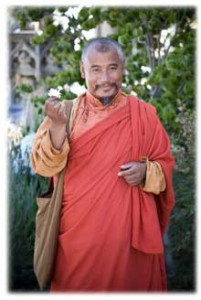
Tsewong Sitar Rinpoche, a great meditation master and Chöd specialist who has spent 20 years in solitary retreat, Tsewong Rinpoche has achieved a high level of inner realization and power.
But he is also renowned in his native Bhutan for his unique healing ability and skills in prophecy.
Tsewong Sitar Rinpoche is a master of the Nyingma tradition of Tibetan Buddhism, trained in the Ngakpa traditions since early childhood.
Program schedule:
Date/Time: Saturday June 4th 2pm-5pm
Dharma talk: Practicing Buddha Dharma in daily life with joy
Venue: Ram’s place, welcome apartment, next to Bangrak police station, Bangkok, please contact 081-9855564 for reservation as spaces are limited
Date/Time: Sunday June 5th 6pm-9pm
Dharma talk: The Four Thoughts that Turn the Mind toward the Dharma
Venue: The Bangkok Shambhala Center, Narathiwat Soi 15, Yaek 8, house #29, Bangkok, Thailand, Space is limited, so please register on the website at www.bangkok.shambhala.info
Dear Friends,
I hope you’ve all been happy and healthy. On this Guru Rinpoche Day, I would like to share with you a pith instruction which my master, Nyoshul Khen Rinpoche repeatedly uttered. It is my hope that this heartfelt advice helps you and guides you on the path. I suggest that you keep this reminder near you so that you are constantly watching your mind.
Mindfulness is the Mirror of the Mind
Obeisance to the king of self arising spontaneous mindfulness! I am the vajra of mindfulness –
Look, vajra brothers and sisters!
Whenever I am seen, mindfulness is maintained. I am the mirror of mindfulness,
Express clearly your careful mindfulness. Do not become distracted, watch the essence of the mind!
Mindfulness is the root of Dharma. Mindfulness is the main path.
Mindfulness is the cane, which sustains the mind. Mindfulness is the friend of self-aware wisdom.
Mindfulness sustains Mahamudra, Dzogchen, and Madhyamaka. Lack of mindfulness is defeat by mara (distraction/disturbing emotions).
Lack of mindfulness will lead you to be distracted by laziness. Lack of mindfulness creates more disturbing emotions and hence failure.
Lack of mindfulness is like a heap of shit. Lack of mindfulness is like sleeping in an ocean of piss.
Lack of mindfulness is like a heartless corpse – Friends I beseech you, maintain mindfulness!
Through the noble master’s sacred aspiration, may you all know the true face of mindfulness.
Me, this elderly monk called Jamyang Dorje, offer this awakening of mindfulness, to all friends with Dharma eyes.
May it be meritorious! May it be auspicious!
Sarva Mangalam,
Phakchok Rinpoche
Dear All Near and Far,
I hope you have all been happy and healthy. I’m writing to you all from Ka-Nying Shedrup Ling Monastery where at present we are performing the annual Tsekar (White Amitayus/Buddha of Longevity) Drupchen (great accomplishment), a nine day ceremony based on a collection of liturgies belonging to the “Great Accomplishment Group Sadhana of White Amitayus”. This drupchen beginning on the 8th day of the fist lunar month of the Tibetan New Year brings forth auspicious circumstances for the practitioners two fold attainment of longevity and primordial wisdom.
When talking about auspicious circumstances for practitioners, the most perfect circumstance for realizing the correct view of emptiness is through generating complete non judgmental and genuine devotion to all the enlightened ones and to cultivate unbound and un fabricated compassion for all sentient beings. Some of you may be practitioners, some interested in practicing and some just receiving this message as a junk, to which I deeply apologize. For you practitioners and for those who are interested in practicing, when you do the practice, you need to have a certain goal or a boundary or a limit to where you want to reach. As mentioned countless times in my previous notes, devotion is key. For devotion, you need to have unerring certainty in the dharma, grounded pure perception, and finally heartfelt kindness of the teachers and the teachings. With these intact, devotion will naturally arise. In the moment of devotion, we should sincerely bring to mind our root gurus along with the lineage gurus and think of their great qualities and with great admiration, supplicate to them. Knowing that it is only through the kindness of the gurus that we’ll be able to understand the ultimate nature of the mind, with such great gratitude, genuine devotion should naturally arise. Devotion should be applied through supplication; physically through putting your palms together, verbally through chanting the supplication, and mentally by aspiring to become a good practitioner in any condition whether in happiness or in sorrow. Your devotion shouldn’t be judgmental as well. If it is, then your devotion is not pure. Devotion is actually a measurement of how deep your understanding of your realization of emptiness is.
Although all sentient beings possess the self existing wisdom, they are unaware of it and as a result beaten relentlessly in the illusory experiences of samsara and suffer tremendously. When seeing such, one should overcome with great compassion and pity. At a moment like this, one should genuinely aspire with great compassion for all sentient beings to be free from suffering and the cause of suffering. Compassion should be without bounds, without attachment, without judgement, without hope and well grounded.
On this 10th day of the first month of the Iron Rabbit Year, Guru Rinpoche renounces his kingdom, practices yoga and meditation in the great charnel ground of Sitavana and attains liberation. Gathering under the matrikas and dakinis, he is known as Guru Shantarakshita.
Keeping you all in my mind on this auspicious day of the auspicious month of the auspicious year!
Sarva Mangalam,
Phakchok Rinpoche
Dear Friends, Near and Far,
Greetings to you all from Nagi Gonpa, the nunnery and hermitage nestled in the serene Shivapuri Mountain of the Kathmandu Valley. Presently at Nagi, we have Chokyi Nyima Rinpoche, Tsikey Chokling Rinpoche and Yangsi Tulku Urgyen Rinpoche all engaged in the yearly nine day Ngakso Drupchen. Ngakso or Ngak kyi Sojong is a Vajrayana practice of mending and purification. Tulku Urgyen Rinpoche explained that in the Ngak kyi Sojong, we are mending and restoring the commitments of the vows of the individual liberation in accordance with the Hinayana system, the bodhisattva trainings, in accordance with the Mahayana system, and the samaya commitments, in accordance with the Vajrayana system. And in terms of the purification, Read the rest of this entry/อ่านรายละเอียด »
Photos from Ringu Tulku Rinpoche visit to Bangkok in January 2011
ภาพถ่ายจากงานบรรยายต่างๆในกรุงเทพฯ ของ ริงกุ ทุลกุ ริมโปเช ในเดือน กุมภาพันธ์ 2554
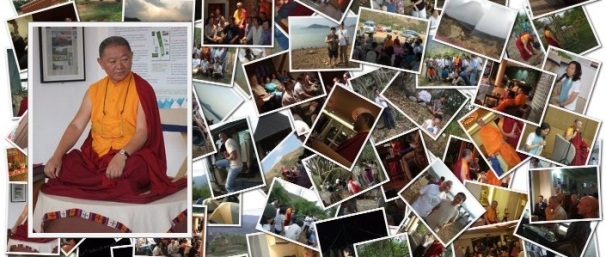
Photos from HH. Phakchok Rinpoche visit to Bangkok in January 2011
ภาพถ่ายจากงานบรรยายต่างๆในกรุงเทพฯ ของสมเด็จพักชก ริมโปเช ในเดือน มกราคม 2554
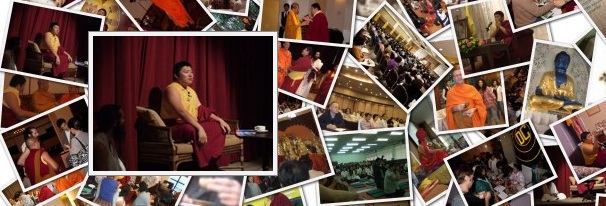
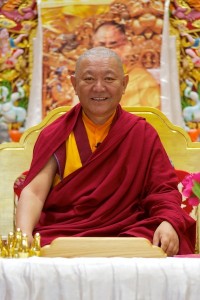 This February 2011 well known Tibetan meditation master, Abbot, professor and writer Ringu Tulku Rinpoche will be teaching at various venues around Thailand. Be sure not to miss this eminent teacher who is well known for his erudition and excellent communication in English.
This February 2011 well known Tibetan meditation master, Abbot, professor and writer Ringu Tulku Rinpoche will be teaching at various venues around Thailand. Be sure not to miss this eminent teacher who is well known for his erudition and excellent communication in English.
ริงกุ ทุลกุ ริมโปเช บรรยายธรรม 2-15 กุมภาพันธ์ Ringu Tulku Rinpoche Dharma talk 2-15 February
รายละเอียดเพิ่มเติม/additional information please check: http://littlebang.org/2011/01/13/ringu-tulku-rinpoche-bkk-feb-2011/
ริงกุ ทุลกุ รินโปเช เกิดปี 1952 ที่แคว้นขาม ในทิเบตตะวันออก ได้รับการสั่งสอนจากพระอาจารย์ที่ยิ่งใหญ่แห่งศตวรรษที่ 16 ได้แก่ HH the 16th Gyalwang Karmapa and HH Dilgo Khentse Rinpoche และได้ศึกษาที่สถาบันนัมกยัล ที่มีชื่อเสียงของโลกที่สนับสนุนให้นักวิจัยสนใจศิลปะและวัฒนธรรมทิเบต และที่มหาวิทยาลัยสัมปุระนานันด์สันสกฤต ท่านได้เดินทางไปสอนพระพุทธศาสนาและการนั่งสมาธิที่มหาวิทยาลัยและศูนย์ปฏิบัติธรรมต่างๆ ในยุโรป สหรัฐอเมริกา แคนาดา และเอเชีย ท่านยังแต่งหนังสือพระพุทธศาสนาทั้งในภาษาทิเบตและยุโรปอีกด้วย
Ringu Tulku Rinpoche is a Tibetan Buddhist Master of the Kagyu Order. He was trained in all schools of Tibetan Buddhism under many great masters including HH the 16th Gyalwang Karmapa and HH Dilgo Khentse Rinpoche. He took his formal education at Namgyal Institute of Tibetology, Sikkim and Sampurnananda Sanskrit University, Varanasi, India and has served as Tibetan Textbook Writer and Professor of Tibetan Studies in Sikkim for 25 years.
Since 1990 he has been travelling and teaching Buddhism and Meditation at Universities, Institutes and Buddhist Centers in Europe, USA, Canada, Australia and Asia. He also participates in various interfaith and Science and Buddhist dialogues. He authored several books on Buddhism as well as some children’s books both in Tibetan and European languages.
—
วันพุธที่ 2 กุมภาพันธ์ 2554, 17.30-20.00 น. ธรรมบรรยาย “ศิลปะแห่งความสุข” (มีแปลไทย)
ณ สวนโมกข์กรุงเทพ (หอจดหมายเหตุพุทธทาส อินทปัญโญ) ข้างสวนรถไฟ ใกล้สถานีรถไฟฟ้าบีทีเอส หมอชิต
แปลไทยโดย รศ.ดร. กฤษดาวรรณ หงศ์ลดารมภ์
Wednesday February 2nd, at 5:30pm – 8:00pm Dharma Talk on “The Art of Happiness” , talk will be in English with Thai translation
Venue: Buddhadasa Indapanno Archives (BIA), Suan Mok Krunthep, next to Mo-chit BTS station
วันพฤหัสบดีที่ 3 กุมภาพันธ์ 2554, 18.30-20.30 น. ธรรมบรรยาย “อริยะสัจจ์ ๔ – จากมุมมองของวัชรยาน” (ไม่มีแปลไทย)
ณ หอประชุมพุทธคยา อาคารอัมรินทร์พลาซ่า (สี่แยกราชประสงค์ – บีทีเอสชิดลม) ชั้น 22 ถ.เพลินจิต
Thursday February 3rd, at 6:30pm – 8:30pm Dharma Talk on “The Four Noble Truths – a Vajrayana Perspective” , talk will be in English only
Venue: DMG Bodhgaya Hall, Amarin Plaza 22nd floor (Chit Lom BTS)
วันจันทร์ที่ 7 กุมภาพันธ์ 2554, 19.00-21.30 น. ธรรมบรรยาย “คำแนะนำสู่การปฏิบัติ มหามุทรา” (ไม่มีแปลไทย)
ณ ศูนย์ชัมบาละ ถนน นราธิวาสฯ ซอย 15 ต้องจองล่วงหน้า http://bangkok.shambhala.info 02 788 7488
Monday February 7th, at 7:00pm – 9:00pm Dharma Talk on “An Introduction to Mahamudra” , talk will be in English only
Venue: Bangkok Shambhala group, Naratiwat rd., Soi 15, near Sathorn
Reservation required, please check http://bangkok.shambhala.info or call Jamie on: 02 788 7488
วันอังคารที่ 8 กุมภาพันธ์ 2554, 10.00-13.00 น. ธรรมบรรยาย “การปฏบัติสมาธิ สุญญตา (ความว่าง)” (ไม่มีแปลไทย)
ณ อาคาร เวลคัม ถนน นเรศ บางรัก ต้องจองล่วงหน้า 081 9855564
Tuesday February 8th, at 10:00am-1:00pm Dharma Talk and meditation on “Emptiness” , talk will be in English only
Venue: Ram’s place near Sam Yan MRT/Subway station in Bangkok followed by lunch together provided from 13.00 free of charge
Reservation required, call Ram 081 985 5564
วันอังคารที่ 8 กุมภาพันธ์ 2554, 18.30-20.30 น. ธรรมบรรยาย “ความโง่เขลาในสังสารวัฏ” (ไม่มีแปลไทย)
ณ ศูนย์เต้นรำ สุขุทวิทย์ ซอย 24
Tuesday February 8th , at 6:30pm – 8:30pm Dharma Talk on “The Foolishness of Samsara” , talk will be in English only
Venue: Dance Centre, Sukhumvit 24, Bangkok
วันพุธที่ 9 กุมภาพันธ์ 2554, 18.00-20.30 น. ธรรมบรรยาย “การก้าวพ้นจากความดึงดูดของสังสารวัฏ” (มีแปลไทย)
ณ หอประชุมพุทธคยา อาคารอัมรินทร์พลาซ่า (สี่แยกราชประสงค์ – บีทีเอสชิดลม) ชั้น 22 ถ.เพลินจิต
Wednesday 9th, at 6:00pm – 8:30pm “How to Transcend the attractions of Samsara” , talk will be in English with Thai translation
(6:00 pm Chanting, followed by talk, short meditation and offerings)
Venue: DMG Bodhgaya Hall, Amarin Plaza 22nd floor (Chit Lom BTS)
วันพฤหัสบดีที่ 10 กุมภาพันธ์ 2554, 19.00-21.00 น. ธรรมบรรยาย “ยานทั้งสามในพุทธศาสนา – ความแตกต่างที่เหมือนกัน” (ไม่มีแปลไทย)
ณ สยามสมาคม ใกล้สถานีรถไฟฟ้าบีทีเอส อโศก, สถานีรถไฟฟ้าใต้ดินสุขุมวิท (มีค่าใช้จ่าย 200 บาทสำหรับผู้ที่ไม่เป็นสมาชิกสมาคม)
Thursday 10th, 7:00pm – 9:00pm Dharma Talk on “The Three Buddhist Yanas – how they are different, yet all the same” , talk will be in English only
Venue: Siam Society, Asoke intersection near BTS/MRT Asoke station (200 baht cover charge for non-members of Siam Soc.)
วันอังคารที่ 15 กุมภาพันธ์ 2554, 18.30-20.30 น. ธรรมบรรยาย “การตายอย่างสงบ” (ไม่มีแปลไทย)
ณ โรงแรมอริยสมวิลล่า สุขุมวิทย์ ซอย 1
Tuesday 15th February, 6:30pm – 8:30pm Dharma Talk on “Dying Gracefully” , talk will be in English only
Venue: Ariyasom Villa Boutique Hotel
You can find more information here:
http://littlebang.org/2011/01/13/ringu-tulku-rinpoche-bkk-feb-2011/
Dear Friends,
I hope you’ve all been happy and healthy. This being the first Guru Rinpoche Day message of the year 2011, and to start off the year auspiciously, I would like to share with you the Five Unshakeable Fortresses that is key for all dharma practitioners.
The Five Unshakeable Fortresses:
The five fortresses are extremely important for all dharma practitioners. If you don’t have these five, then actually it means that you are not doing quite so well…
1. Gaining Certainty in the View
Many of us when practicing the dharma are so busy doing things, physically, in the dharma world. Such as offering butter lamps, doing circumambulations, reading many texts, doing a lot of different daily practices, and while doing so, our precious time runs out. Though the time is not wasted on doing something unnecessary, but while engaging in doing these “dharmic activity”, we sometimes loose the focus or the point of doing it all and therefore completely lack in gaining certainty in and reconfirming, the view.
The earlier masters all said this so many times. Tilopa said that when you’ve lost the correct view your practice is gone. You may be very devoted and have a lot of faith, but you’re not going to have a correct practice because you lack the correct view. So the first most important thing is having certainty in the view.
How to get that?
Reinvestigating your emotions, your ego, ‘I’, your judgmental mind.
Why does my judgmental mind work so well?
Because I’m not reconfirming my understanding of egolessness.
Why are my negative emotions working so well?
Because, I’m not reconfirming my understanding of egolessness.
Why am I so moody?
Because, you forgot to reconfirm egolessness, selflessness. Really.
Why can we not have compassion that is free from judgment?
Because we lack an understanding of egolessness.
Why can we not have trust in emptiness?
Because we cannot gain trust in egolessness. That’s why.
Why when you practice the deity, do you see the deity as truly existent?
Because you have no understanding of egolessness.
So whatever practice you do, spend at least some time to re-investigate your emotions, your ‘I’, your judgment, your ego, your clinging, your anxiety. That is gaining certainty in the view and that means you are making an unshakeable fortress of the view.
2. Being Undistracted in Meditation
We talk about meditation all the time. This meditation, that meditation. Shamatha, Vipashyana, Mahamudra, the Development Stage, Mind Training, the Middle Way, the Great Perfection! But whatever meditation you do, we talk about five stages: movement, attainment, familiarization, stability, and perfection. The first is like a waterfall, the second a river gorge, the third a calm river, the fourth an ocean without waves, and the fifth like an unshakeable mountain. These experiences are actually measurements.
Measurements of what? Measurements of distraction. Having the most distraction is the first experience, the waterfall, and having a little less distraction is the river gorge. Again, when you’re a little calmer and when the rough distractions are gone, but subtle distractions are still there, it is the calm river. If you have less subtle distraction, that’s the ocean without waves, and even less, the mountain. So when you do meditation, you should know that the unshakeable fortress of meditation is non-distraction.
3. Conduct
Dharma practitioners should have a good conduct. Conduct is very important and on a simple level, we can say not doing harmful things to oneself and others and doing things to benefit others and oneself. Basically not harming others physically, verbally, or mentally. Bottom line; always being mindful of your conduct.
In the Mirror of Mindfulness, my master, Nyoshul Khen Rinpoche said, “When you don’t have mindfulness, you are a shit pot. When you don’t have any mindfulness, you are a dead body.”
To clarify Rinpoche’s quote, no matter how much you clean yourself, with brushing or washing, if you are not mindful of your conduct, you are always carrying that shit around and therefore you are always going to smell of shit no matter what. It is all the works of this “deluded mind” that we grasp to “what is” to “what is not” and therefore see unclean as clean, to what is impermanent as permanent, to what is selfless as having self, and to pain as pleasure.
So how can we work with this delusion?
By practicing mindfulness.
How to practice mindfulness in conduct?
By reminding. Not watching, but reminding yourself in whatever you do, to not forget what the buddhadharma really is. When you walk around the Buddha’s stupa in Boudhanath, remind yourself that you are walking around it to tame your mind. Remind yourself, “I am studying for enlightenment, to tame my mind.” Whatever you do, you need to remember the main core of the Buddha’s teaching; that is real conduct, how to keep conduct well. So please take it to heart.
I remember our late principal, Khenpo Kunga Wangchuk constantly telling the graduating class, “If you cannot help the dharma, at least don’t harm the dharma. Keep that in mind. Don’t think that you are acting alone. Individually, you are a pillar of the dharma. Individually, you represent the dharma. And therefore individually, your conduct will have a consequence on the dharma.” So mindfulness in conduct is the key.
4. Clearing Away Obstacles
When you start practicing the dharma, you’re going to face obstacles. I asked Nyoshul Khen Rinpoche one day, “Rinpoche, why is it like this? Whenever I want to do some kind of practice, I have an obstacle. Whenever I don’t want to do practice, I have no obstacle. Why is it like this?” For example, whenever I start meditating, all my worries come up and whenever I meditate my answers to those worries also come. Whenever I start thinking, the answers don’t come!
When you have difficulties in meditation, what is the best way to remove them? You can check many Mahasiddhas’ methods, many different masters’ texts, but all the time they say the same thing. What? Devotion. All the time they say this, and we have difficulty with that. It’s difficult for us to practice devotion, but if you look in any text, by Tilopa, Maitripa and so on, they all say, “Visualize the guru above your head surrounded by the lineage masters, and supplicate to them, receive the four empowerments, and think that your obstacles have all been removed.” In all the meditation manuals it teaches the same thing. So devotion is key.
What is devotion like? It has three qualities: certainty in the dharma, pure perception, and remembering the kindness. Parents’ kindness is extremely important: your mother keeps you for nine months in her womb, gives birth to you, feeds and clothes you, and helps you grow up. Our parent’s kindness is very important. But who teaches you to be independent? Who teaches you to actually be free from your emotions and suffering? Who guides you towards the truth so that you can actually be free? It’s the guru. That is remembering the kindness. Then we also have certainty and pure perception. With these three qualities, you can develop devotion easily.
5. Enhancement
How to enhance or improve your practice? First of all, why actually can we not improve our practice that much? It is because we have so many things to hold on to, and to get hooked with. For someone like me, we have monasteries, monks, projects, and all the planning that goes along with it. For some practitioners, it’s deities and accumulating merit, and for some, families, cars, your favorite brand, etc. These days, I’ve started liking the brand Burberry. Before I didn’t even know what it was, but now I really like it, and it’s very expensive. I love Mont Blanc too. There’s nothing there actually, but I like it. When people look at you, if you’re wearing a Mont Blanc pen, you’re okay, but if you’re wearing a lousy pen then you are judged to be worth just that. So all the time, we are judging and being judged. And now you feel you need to keep up to that. You start holding onto things, getting attached, worrying, and that’s why our meditation practice cannot improve well.
That’s why many great masters of the past practiced pongdag. For example, I heard that when Dilgo Khyentse Rinpoche reached Bodhgaya in India, a long time ago, he decided to give everything up through pongdag. Pongdag literally means to give up or to abandon. Khenpo Ngakchung did this three times. I also heard a story about Trulshik Rinpoche. For old masters, old statues are extremely important for them. You can give them a kilo of gold and they don’t care at all, but they really treasure their old statues. When Trulshik Rinpoche was receiving empowerments from Dilgo Khyentse Rinpoche, he cleaned out his entire altar by offering all of his precious statues to him.
In the past, I would count everyday how many things I owned, how many things I had to give up. I would count each thing on my fingers. We need to learn how to do this, how to practice pongdag mentally, to give up everything, and offer it as a mandala offering.
Many masters say that when you go to retreat, you need to cut your worldly perceptions and then your practice will improve very fast, but if you bring worldly concerns with you then your practice won’t improve as much. So I try to tell myself everyday when doing meditation, first of all, to give up my projects, my house, everything. This is what I do first for five minutes. After that I give rise to devotion and supplicate and then I meditate. If you do that, your meditation will improve so fast that you will be amazed.
So these are called the five unchanging fortresses of the dharma practitioner.
Certainty in the view
Non-distraction in meditation
Mindfulness in conduct
Dispelling obstacles with devotion
Enhancing through pongdag
Don’t forget these five, and try to improve them. When you can improve these five things in yourself, your practice is going to improve. You can check a hundred texts, meet a thousand masters, but they are not going to say anything more than this. When practicing, too much information isn’t that helpful, but one pithy piece of advice, a key, can help us change a lot!
Sarva Mangalam,
Phakchok Rinpoche
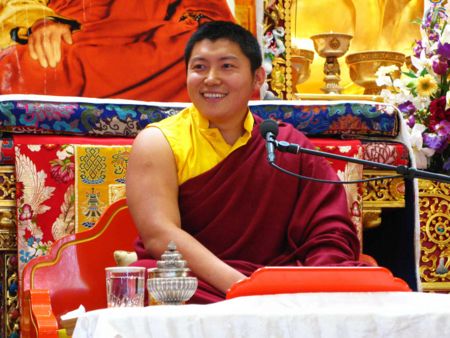
เป็นผู้สืบทอดการปฏิบัติสาย ชกจูร์ ลิงปะ (Chok Gyur Lingpa Lineage) แห่งนิกายญิงมา-ปะ (Nyingma School of Early Translation) ซึ่งเป็นนิกายโบราณของพุทธศาสนาวัชรยาน ท่านสืบเชื้อสายมาจาก ชกลิง ริมโปเช (His Eminence Chokling Rinpoche) และ ดีเชน ปาลดรอน (Dechen Paldron) เกิดเมื่อปี พ.ศ. 2525 ที่ประเทศเนปาล ท่านเดินทางเผยแผ่พุทธศาสนาในหลายๆประเทศ ซึ่งเอกลักษณ์ในการถ่ายทอดคำสอนของท่านมีลักษณะตรงไปตรงมา และเข้าใจง่าย
ตำแหน่งปัจจุบัน
• ผู้ครองบัลลังก์สายการปฏิบัติ “ รีโวเช ตักลุง การ์จู (Riwoche Taklung Kagyu Lineage) ” แห่งวัดรีโวเช (Riwoche Monastery)
• วัชราจารย์ของวัดกาญิง เชดรุป (Vajra Master: Ka-Nying Shedrub Ling Monastery) ที่ โพธนาถ (Boudhanath) เมืองกาฐมัณฑุ ประเทศเนปาล
• เจ้าอาวาสวัดโดงัก ญีดา ซุงเทรล เชดรุป รัลตรี (Abbot of Do-ngak Nyida Zungdrel Shedrab Raldri Ling Monastery) ประเทศเนปาล
• เจ้าอาวาสวัดปัล การ์จู เชดรุป ตาชี ทาเกย์ พุนสก (Abbot of Pal Kagyu Shedrub Tashi Dhargye Phuntsok Ling Monastery) ประเทศเนปาล
• ประธานของ รังจุง ยีชี เช็นเปน (President of Rangjung Yeshe Shenpen) อันเป็นองค์กรการกุศล เพื่อช่วยเหลือผู้ยากไร้ และผู้ด้อยโอกาสด้านการศึกษาและสาธารณสุขในประเทศเนปาล
• ศาสตราจารย์วิชาพุทธปรัชญา (Professor of Buddhist Philosophy) ที่สถาบันรัง จุง ยีชี (Rangjung Yeshe Institute Shedra) ศูนย์พุทธศาสนศึกษา (Center of Buddhist Studies) มหาวิทยาลัยกาฐมัณฑุ (Kathmandu University) ประเทศเนปาล ท่านสอนพุทธปรัชญาทั่วไปโดยเฉพาะอย่างยิ่งปรัชญามาธยมิกะ (The Middle Way)
การศึกษา
• ได้รับวุฒิทางการศึกษาระดับ “เคนโป (mKhan po)” ซึ่งเทียบเท่าปริญญาเอก (Ph.D.) ทางศาสนาวิทยา (Doctor of Divinity) จากองค์สมเด็จดาไลลามะที่ 14 (His Holiness 14th Dalai Lama) และจาก จงซาร์ เคียนเซ ริมโปเช (H.E. Dzongzar Khyentse Rinpoche)
• จบการศึกษาหลักสูตรพุทธปรัชญาที่สถาบันการศึกษาพุทธศาสนาชั้นสูงจงซาร์ (Dzongsar Institute of Advanced Buddhist Studies) ที่ เมืองบีร์ (Bir) มณฑลหิมาจัล (Himachal Pradesh) ประเทศอินเดีย (India) ซึ่งเน้นการศึกษาด้านคำสอนของ สายสาเกียปะ กับ เคนเชน กุงกา วังชุก ริมโปเช (Khenchen Kunga Wangchuk Rinpoche) และ จงซาร์ เตียนเซ ริมโปเช (H.E. Dzongsar Khyentse Rinpoche) ซึ่งท่านใช้เวลาในการศึกษาเพียง 7 ปี จากเวลาปกติ 9 ปี
งานเผยแผ่
• วิทยากรรับเชิญบรรยายธรรม ณ ศูนย์ปฏิบัติธรรมหลายแห่งทั่วโลก อาทิ ประเทศเดนมาร์ก ประเทศเยอรมันนี ประเทศออสเตรีย ประเทศสวิสเซอร์แลนด์ ประเทศเบลเยี่ยม ประเทศสหรัฐอเมริกา ประเทศแคนาดา ประเทศอเมริกา ประเทศอเมริกาใต้ และ ประเทศแถบเอเซียตะวันออกเฉียงใต้ ฯลฯ
• ผู้ก่อตั้งศูนย์ปฏิบัติธรรมหลายแห่งในประเทศมาเลเซีย
Kyabgon Phakchok Rinpoche is a lineage holder of the Profound Treasures of Chokgyur Lingpa from the Nyingma School of Early Translation and throne-holder of Riwoche Taklung Kagyu Lineage.
Currently duties
• Vajra Master of Ka-Nying Shedrub Ling Monastery (in Boudhanath Kathmandu, Nepal)
• Abbot of Pal Do-Ngak Nyida Zungdrel Mindrol Norbuling Monastery (Nepal)
• Abbot of Pal Kagyu Shedrub Tashi Dhargye Phuntsok Ling Monastery (Nepal)
• President of Rangjung Yeshe Shenpen Nepal, a volunteer-based, non-profi t organization that serves the poor and disadvantaged in Nepal
• Professor of Buddhist Philosophy, Rangjung Yeshe Institute Shedra, Center of Buddhist Studies, Kathmandu University, where he teaches general Buddhist philosophy with emphasis on the Middle Way
Education
Phakchok Rinpoche received the Khenpo title (similar to a Doctor of Divinity) from H.H. 14th Dalai Lama and H.E. Dzongsar Khyentse Rinpoche. He completed in seven years the traditional nine-year curriculum of Buddhist philosophy at the Dzongsar Institute of Advanced Buddhist Studies, Bir, Himachal Pradesh, India, where he specialized in studies of the Sakya School of Tibetan Buddhism under the guidance of Khenchen Kunga Wangchuk Rinpoche and H.E. Dzongsar Khyentse Rinpoche.
An enthusiastic and vibrant young teacher, Phakchok Rinpoche’s lectures are direct and easily understood. Since 1999 he has served as Professor of Buddhist Philosophy at the Rangjung Yeshe Institute Shedra, Center of Buddhist Studies, Kathmandu University, where he teaches general Buddhist
philosophy with emphasis on the Middle Way. He has also been guest-lecturer at numerous centers in Europe, North America, South America, and South East Asia.
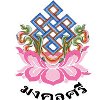



 This February 2011 well known Tibetan meditation master, Abbot, professor and writer Ringu Tulku Rinpoche will be teaching at various venues around Thailand. Be sure not to miss this eminent teacher who is well known for his erudition and excellent communication in English.
This February 2011 well known Tibetan meditation master, Abbot, professor and writer Ringu Tulku Rinpoche will be teaching at various venues around Thailand. Be sure not to miss this eminent teacher who is well known for his erudition and excellent communication in English.